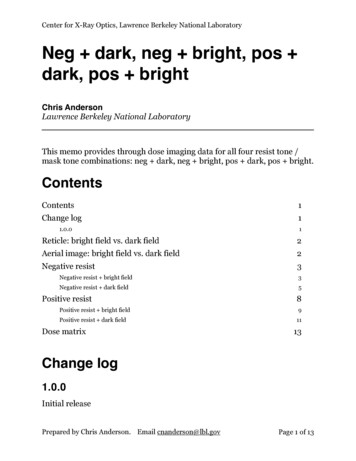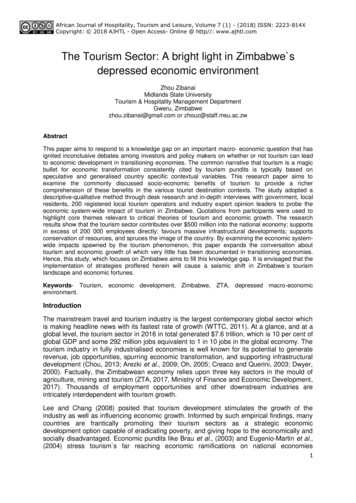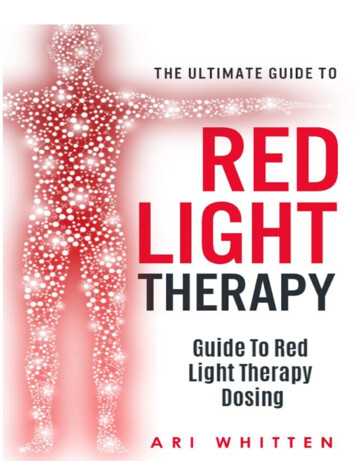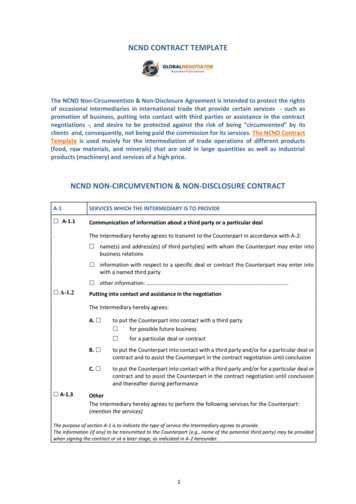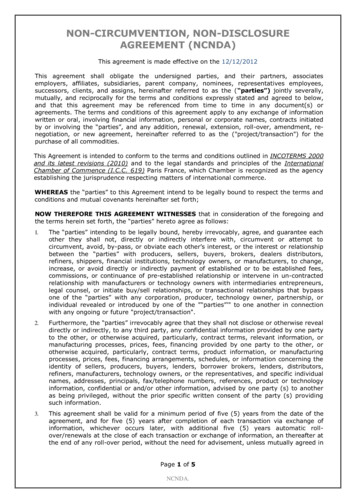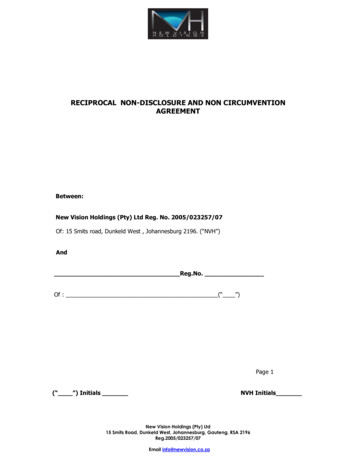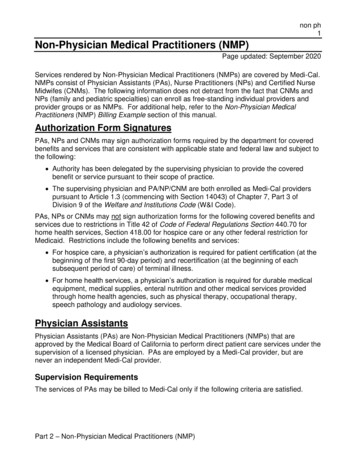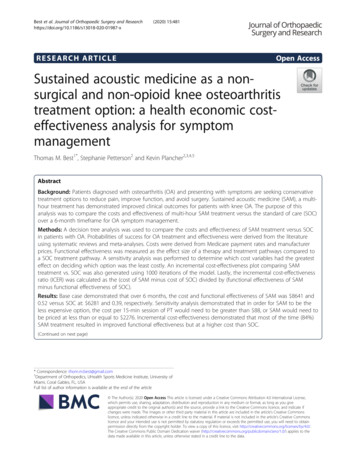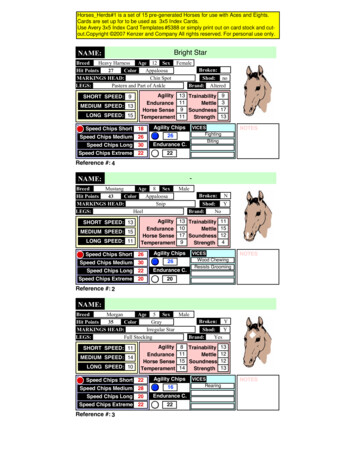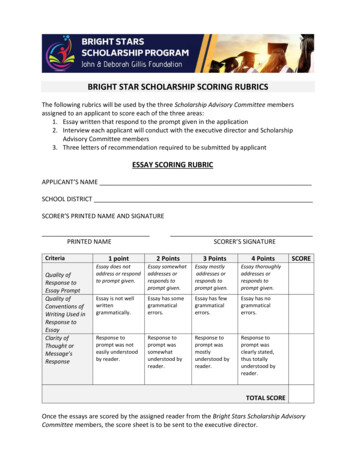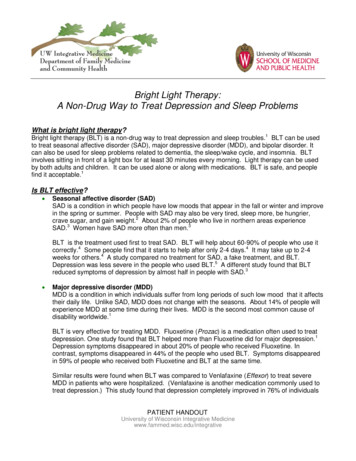
Transcription
Bright Light Therapy:A Non-Drug Way to Treat Depression and Sleep ProblemsWhat is bright light therapy?Bright light therapy (BLT) is a non-drug way to treat depression and sleep troubles.1 BLT can be usedto treat seasonal affective disorder (SAD), major depressive disorder (MDD), and bipolar disorder. Itcan also be used for sleep problems related to dementia, the sleep/wake cycle, and insomnia. BLTinvolves sitting in front of a light box for at least 30 minutes every morning. Light therapy can be usedby both adults and children. It can be used alone or along with medications. BLT is safe, and peoplefind it acceptable.1Is BLT effective? Seasonal affective disorder (SAD)SAD is a condition in which people have low moods that appear in the fall or winter and improvein the spring or summer. People with SAD may also be very tired, sleep more, be hungrier,crave sugar, and gain weight.2 About 2% of people who live in northern areas experienceSAD.3 Women have SAD more often than men.3BLT is the treatment used first to treat SAD. BLT will help about 60-90% of people who use itcorrectly.4 Some people find that it starts to help after only 2-4 days.4 It may take up to 2-4weeks for others.4 A study compared no treatment for SAD, a fake treatment, and BLT.Depression was less severe in the people who used BLT.5 A different study found that BLTreduced symptoms of depression by almost half in people with SAD.3 Major depressive disorder (MDD)MDD is a condition in which individuals suffer from long periods of such low mood that it affectstheir daily life. Unlike SAD, MDD does not change with the seasons. About 14% of people willexperience MDD at some time during their lives. MDD is the second most common cause ofdisability worldwide.1BLT is very effective for treating MDD. Fluoxetine (Prozac) is a medication often used to treatdepression. One study found that BLT helped more than Fluoxetine did for major depression.1Depression symptoms disappeared in about 20% of people who received Fluoxetine. Incontrast, symptoms disappeared in 44% of the people who used BLT. Symptoms disappearedin 59% of people who received both Fluoxetine and BLT at the same time.Similar results were found when BLT was compared to Venlafaxine (Effexor) to treat severeMDD in patients who were hospitalized. (Venlafaxine is another medication commonly used totreat depression.) This study found that depression completely improved in 76% of individualsPATIENT HANDOUTUniversity of Wisconsin Integrative Medicinewww.fammed.wisc.edu/integrative
Bright Light Therapywho received Venlafaxine and BLT together.6 Depression completely improved in only44% of patients who did not receive BLT. These two studies show that BLT along withmedications can improve depression more than medications alone. Depression alsoimproves faster when BLT is used in addition to medications.6 Bipolar disorderBipolar disorder is a condition in which people have extreme mood swings from very low(depression) to very high (mania). These mood swings affect their energy, activities,ability to do daily tasks, and sleep. BLT can help improve depression in people withbipolar disorder. BLT is safe and effective for the low moods of bipolar disorder whenused along with medications that help even out mood.7 BLT can trigger a manic mood,4so if you think you might have bipolar disorder and are not on medications for it, talk withyour health care professional before using BLT. Mania caused by BLT is rare.7 Whilehelpful, BLT may not help as much for bipolar disorder as it does for SAD and MDD.8 Sleep problemsBLT is an effective treatment for some sleep conditions. These include difficulties with thesleep/wake cycle, insomnia, and sleep problems related to Alzheimer’s disease and othertypes of dementia. BLT works best when it is combined with other treatments. Sleepimproves the most if a person uses a light box of strong intensity (10,000 lux). BLTimproves the sleep problems of women with Alzheimer’s disease and other dementiasmore than it does for men with these conditions.9 BLT in childrenBLT is a safe and effective way to treat depression in children. Sleep quality alsoimproves in children using BLT. BLT helps even if a child is taking medications. Overall,BLT is not as helpful for depression in children as it is for adults.10How does BLT work?How BLT works is not fully understood. SAD is thought to occur because of a decrease in theamount of light a person is exposed to during the fall and winter months. Less light affects thesleep/wake clock in the brain. This changes how some chemicals in the brain (such as serotoninand melatonin) are produced. When these chemicals are not balanced, changes in mood and thesymptoms of SAD and MDD can occur.It is believed that the light used in BLT travels to the cells in the back of the eye. These cellssend signals to the brain to change the production of brain chemicals. Low moods, then,improve with BLT because of changes in the balance of brain chemicals and changes in thesleep/wake cycle.1,2,7,11,12What are the side effects of BLT?BLT is a safe treatment for depression and some sleep conditions. There are few side effectsfrom using a light box and generally no long-term complications. The most common side effectsPATIENT HANDOUTUniversity of Wisconsin Integrative Medicinewww.fammed.wisc.edu/integrative2
Bright Light Therapyare headaches, eye irritation, visual glare, and feeling “wired.” About 18% of people who uselight therapy will have nausea.7 Side effects usually decrease with time. Side effects will alsodecrease if the light box is used for shorter amounts of time or if a lower intensity light box isused.7No known long-term eye problems occur from using a light box with a good ultraviolet (UV) lightfilter. Side effects such as blurry vision, eyestrain, and increased sensitivity to light are morelikely to occur if the light box is too close to the eyes.7 If you have an eye condition, talk with youreye doctor before starting BLT.13BLT can trigger a manic mood.4 If you have mood swings and are not on medications for bipolardisorder, talk with your health care professional before using BLT. Mania caused by BLT is rare.7Fewer side effects occur when BLT and medications are used together to treat depression, ratherthan when either is used alone.1 This suggests that using BLT while taking medications may helpimprove some of the side effects of medications.What light box should I use?There are many different types of light boxes available. Light boxes can be purchased at mostdepartment stores and online. The price of a light box can range from forty to several hundreddollars. Bigger and more intense light boxes are usually more expensive. Unfortunately, mostinsurance companies currently do not cover the cost of a light box, but you can check with yourinsurance company to see if they cover it.Use the following recommendations to choose a safe and effective box: Make sure to get a box that is used to treat symptoms of depression.Some skin conditions are treated with light boxes. These boxes are different than theones used to treat depression. The light box to treat depression should have a UV filter.This will protect your skin and eyes from harmful UV rays while still giving you the lightneeded for BLT to be effective.7 A higher intensity box will require less time per day.A 10,000-lux light box is recommended. The intensity of light boxes that work best rangefrom 2,500-10,000 lux. You will need to use a 2,500-lux box longer each day compared toa 10,000-lux box. A box less than 2,500 lux will not be helpful. A box that has more than10,000 lux is not more helpful and will still require 30 minutes daily. Your symptoms willimprove quicker if you use a 10,000-lux box rather than one with 2,500 lux.7,13 If possible, choose a light box that emits white light.Many wavelengths of light are used in light boxes. White light has been researched themost. Blue light may also be effective, but there is less research to support using bluelight.13 Also, white light causes fewer eye side effects than blue light.7 Choose the box with the largest light surface that is practical for your home andbudget.Light boxes with larger screens cause fewer eye side effects than do small ones.7PATIENT HANDOUTUniversity of Wisconsin Integrative Medicinewww.fammed.wisc.edu/integrative3
Bright Light Therapyhttp://www.sadlightreview.com/day-light- 1How to use a light boxTo receive the most benefit from your light box, it is important to use it properly. When should I use my light box?Light boxes should be used every day.o If you have SAD, use your light box daily throughout the fall and winter. You canstop in the spring and summer.o If you have MDD, you will likely need to use your light box daily while you arefeeling depressed, even in summer. If you stop using the box too early, yoursymptoms may return.4o There are no clear guidelines on how to use the light box for sleep. If you use BLTfor sleep, use the light box for as long as you feel it is helping you. How do I use a light box?Sit in front of the light box every day. The instructions that come with the light box will tellyou the distance to sit from the box. It is important that the light is in front of you and notbehind you, so that the light can reach your eyes. Do not stare directly into the light. Justdirect the light downward towards your face. Using your light box at a downward anglewill help decrease eye side effects.7 What time of day should I use my light box?It is best to use your light box as early as possible in the morning after you wake up. 2, 13Some studies have found that using the light box at night is also effective if you cannotfind time in the morning. If you use the light box at night, you may find it more difficult tofall asleep at your regular bedtime.PATIENT HANDOUTUniversity of Wisconsin Integrative Medicinewww.fammed.wisc.edu/integrative4
Bright Light Therapy How long do I have to use it every day?How long you will need to use your light box will depend on the intensity of your box. Fora 10,000-lux box 30 minutes every morning is effective. A 5,000-lux box will require 45-60minutes daily. A 2,500-lux box will require you to use it for 2 hours daily to beeffective.7,11,13 How long will BLT take to work?Some people find that BLT starts to help after only 2-4 days.4 For others, it may take upto 2-4 weeks.4 A good length of time to try the light box is 2-4 weeks. If your symptomshave not improved after 2-4 weeks of daily use, it may be a good idea to talk with yourhealth care practitioner to discuss whether BLT is a good choice for you.4,7 Can I just sit outside instead of getting a light box?Bright sunlight emits about 110,000 lux. This means that if you live in a sunny area, beingoutdoors is a great way to get natural light. Getting natural light outside requires less timein the sun than sitting in front of a light box. Going outside to get natural sunlight may alsoencourage you to be more physically active, which is helpful for decreasing depression.However, if you live in an area that does not get a lot of sun year-round, a light box is agreat option.14,15If you choose to use natural sunlight: Try to get sunlight as early after waking as possible.That is the most helpful for treating depression. Also, damaging UV light is lower at thattime of the day. You can protect your skin from UV rays that cause skin cancer by usingsunscreen or clothing that covers your skin.13 Will the standard light bulbs I have in my house do the same thing?Indoor lighting, even if it seems very bright, is not strong enough to treat symptoms ofdepression. You can get natural sunlight by sitting next to a window in your home, butstandard home light bulbs will not be helpful.13 Summary of Bright Light TherapyLight boxes are an effective way to treat seasonal affective disorder, major depressivedisorder, bipolar disorder, and sleep difficulties.Both adults and children can use light boxes safely.BLT is helpful by itself. Using BLT and medications together is even more effective.BLT has few side effects. They decrease over time.The best light box to use will have 10,000 lux, a UV filter, white light, and is the largestsize that works for your home and budget.Use your light box for 30 minutes every day.Talk to your health care practitioner if you have questions or concerns about using alight box.PATIENT HANDOUTUniversity of Wisconsin Integrative Medicinewww.fammed.wisc.edu/integrative5
Bright Light TherapyReferences1. Lam RW, Levitt AJ, Levitan RD, et al. Efficacy of bright light treatment, fluoxetine, and the combinationin patients with nonseasonal major depressive disorder: A randomized clinical trial. JAMA Psychiatry.2016;73(1):56-63.2. Nussbaumer B, Kaminski-Hartenthaler A, Forneris CA, et al. Light therapy for preventing seasonalaffective disorder. Cochrane Database Syst Rev. 2015;11. Art. No.: CD011269. doi:10.1002/14651858.CD011269.pub2.3. Danilenko KV, Ivanova IA. Dawn simulation vs. bright light in seasonal affective disorder: Treatmenteffects and subjective preference. J Affect Disord. 2015;180:87-89.4. Kennedy SH, Lam RW, Cohen NL, Ravidran AV, CANMAT Depression Work Group. Clinical guidelinesfor the treatment of depressive disorders. IV. Medications and other biological treatments. Can JPsychiatry. 2001;46(Suppl 1):38S–58S.5. Golden RN, Gaynes BN, Ekstrom RD, et al. The efficacy of light therapy in the treatment of mooddisorders: a review and meta-analysis of the evidence. Am J Psychiatry. 2005;162(4):656–662.6. Özdemir PG, Boysan M, Smolensky MH, et al. Comparison of venlafaxine alone versus venlafaxineplus bright light therapy combination for severe major depressive disorder. J Clin Psychiatry.2015;76(5):645–654.7. Terman M, Terman JS. Bright light therapy: side effects and benefits across the symptom spectrum. JClin Psychiatry. 1999; 60:799–808.8. Camardese G, Leone B, Serrani R, et al. Augmentation of light therapy in difficult-to-t
Bright light therapy (BLT) is a non-drug way to treat depression and sleep troubles.1 BLT can be used to treat seasonal affective disorder (SAD), major depressive disorder (MDD), and bipolar disorder. It can also be used for sleep problems related to dementia, the sleep/wake cycle, and insomnia. BLT involves sitting in front of a light box for at least 30 minutes every morning. Light therapy .
